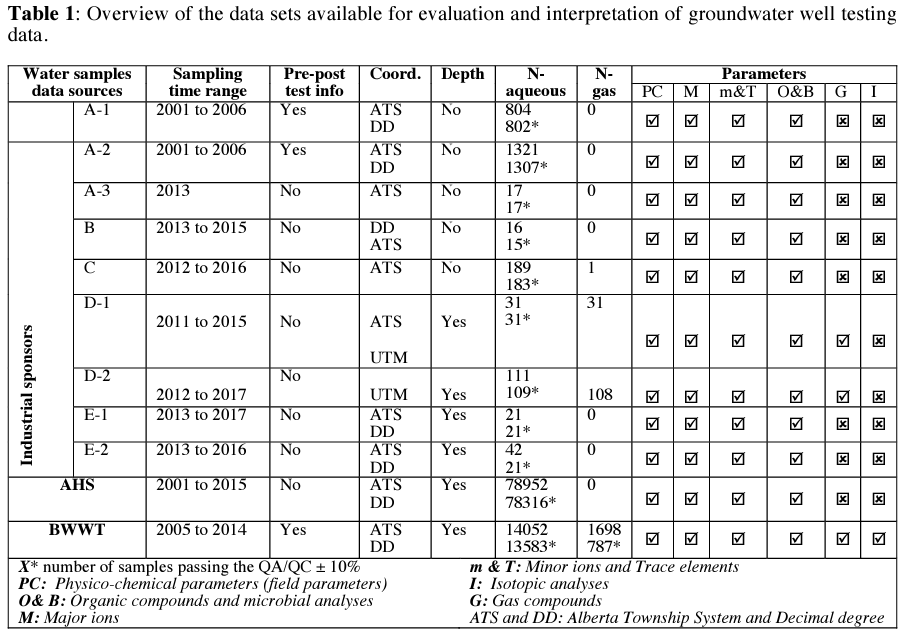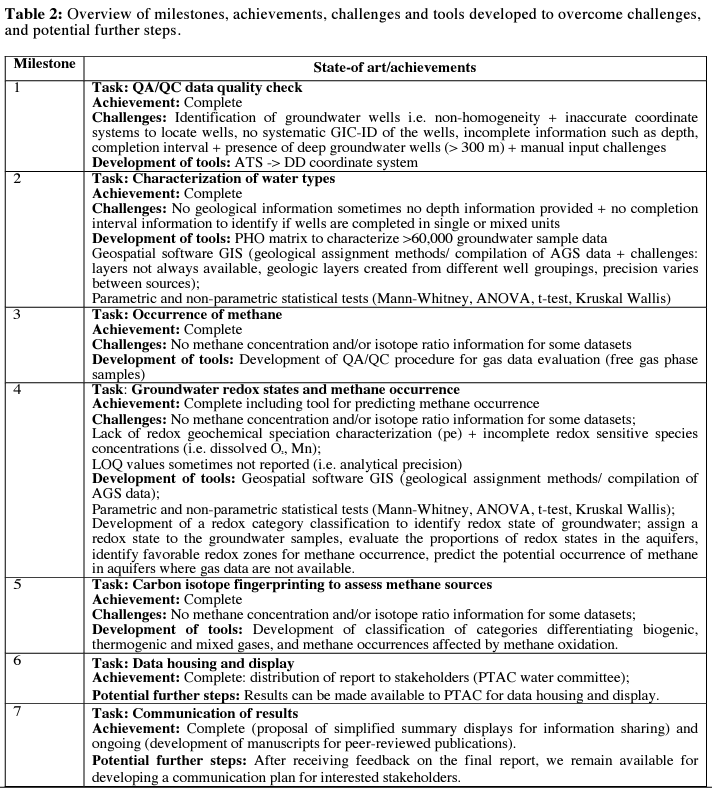Pauline Humez, Leah Wilson, Michael Nightingale & Bernhard Mayer, Applied Geochemistry group, Department of Geoscience, University of Calgary
2018
Executive Summary
In this project, the research team investigated three datasets comprising geochemical data for 95,556 water samples (see overview in Table 1). We had access to data from industry from five different companies that contained physico-chemical parameters (e.g. field parameters), major ions, some minor ions and trace element concentrations, and usually also microbial parameters and concentrations of selected organic compounds (e.g. BTEX). One industrial data source (D) contained also gas concentration data (i.e. methane and sometimes ethane). None of the industrial data sources reported carbon isotope analyses for methane or other alkanes in dissolved or free gas samples. In the Alberta Health Services (AHS) database we evaluated 78,952 different water samples, of which 67,590 are geographically referenced. The database contains physico-chemical parameters (e.g. field parameters), major ions, some minor ions and trace element concentrations, and microbial analyses, but no gas compositional or isotope data for dissolved or free gases. We also evaluated the BWWT database that contains physico-chemical parameters (e.g. field parameters), major ions, some minor ions and trace element concentrations, and some organic compounds and microbial analyses, as well as compositional and carbon isotope data for free gases for a subset of samples.

Project achievements and milestones reached
A summary of all achievements for each milestone is provided in Table 2.
Milestones 1: QA/QC data quality check
For all available aqueous and gas samples a rigorous QA/QC procedure was applied. For aqueous geochemistry data, 2,506 samples of the industry database, 78,316 samples of the AHS database, and 13,583 samples of the BWWT database passed the QA/QC test. For gas geochemistry data, 139 samples from the industry database, and 787 samples from the BWWT database passed the QA/QC test. Only samples passing the QA/QC tests were further evaluated. Milestone 1 was fully achieved.
Milestones 2: Characterization of water types
Analysis of the predominant water types in the AHS, BWWT and industry data sets revealed that sodiumbicarbonate waters comprise the majority of all samples (>52%) followed by sodium-bicarbonate-sulfate waters (~11%). Other important water types include calcium-(magnesium-)bicarbonate waters (~14% of all samples) and Na-SO4 type waters (<6 % of all samples). In-depth analysis revealed that the deepest groundwater wells are frequently associated with samples characterized by the Na-HCO3 water type. No major differences were found in dominant water types between groundwater obtained from different geologic units. The three ubiquitous Na-rich water types, Na-HCO3 , Na-HCO3-SO4 and Na-SO4 , were dominant in all geologic units from the Belly River Group to the Paskapoo Formation. Milestone 2 was fully achieved.
Milestones 3: Occurrence of methane
The investigation of occurrence of methane in free gas samples is limited to the BWWT database, since the industry and AHS data do not contain information on free gases. QA/QC procedures resulted in 787 free gas samples that contain n-alkane geochemical information including methane concentrations (n= 787) and associated carbon isotope ratios (n= 517), ethane concentrations (n=364) and its carbon isotope ratios (n=253), and propane concentrations (n=106). The median concentrations of methane, ethane and propane were 543,300 (n= 787), 1,007 ppmv (n=364), and 100 ppmv (n=106), respectively. The highest concentrations of methane in free gas samples were observed in groundwaters belonging to Na-HCO3 , NaHCO3-Cl and NaCl water types. Sulfate-containing water types were typically characterized by much lower median methane concentrations of <150,000 ppm. The highest methane concentrations were observed in groundwater from the Horseshoe Canyon Formation. Milestone 3 has been reached and the task is fully completed.
Milestones 4: Groundwater redox states and methane occurrence
While investigating aqueous geochemistry trends in samples from the BWWT and some industry databases, it was observed that samples with elevated nitrate and high sulfate concentrations did usually not contain methane. In contrast, samples with negligible nitrate concentrations (<0.1 mM) and sulfate contents below a threshold of 1.0 mM frequently contained methane. This is consistent with the redox ladder concept that states that denitrification and bacterial sulfate reduction must occur first before methanogenic microorganism can generate biogenic methane in-situ in highly reducing aquifers. Using this concept, we developed a classification scheme that uses the results of aqueous geochemical analyses of groundwater samples to determine the redox state of the aquifer from which the groundwater was obtained. To test the accuracy of this approach, we applied the developed redox category concept to 762 groundwater samples of the BWWT database that also had free gas samples passing the QA/QC test. We found that 64% of the groundwater samples indicated a methanogenic groundwater and that 88% of these samples contained methane with elevated concentrations of >150,000 ppmv. Approximately 30% of the groundwater samples belonged to the sulfate reducing redox zone and 83% of these samples contained methane with less than 150,000 ppmv. Groundwater samples belonging to less reducing redox zones (denitrification, Mn-reduction) were usually not characterized by elevated methane concentrations. Hence, the developed methodology appears highly effective in predicting the occurrence of elevated methane in shallow aquifers based on aqueous geochemistry data alone. Using this approach for redox class assignment, we were able to predict that ~48% of the groundwater samples in the AHS database are likely favorable for methane occurrence in the aquifers. Milestone 4 has been reached and the task has been fully completed.
Milestones 5: Carbon isotope fingerprinting to assess methane sources
The investigation of carbon isotope ratios of methane and ethane was limited to the BWWT database, since the industry and AHS data do not contain information about carbon isotope ratios of gases. Methane and ethane in free gas samples had median δ 13 CCH4 values of -67.3 ‰ (n = 518) and δ 13 CCH4 values of -49.1 ‰ (n= 395) respectively. Carbon isotope ratios of propane were only determined for 20 samples with a median δ 13 CCH4 value of -32.1 ‰ (n= 20). It was found that the majority of the methane-containing samples were characterized by δ 13 C values of methane < -55 ‰ (n=447) while low to negligible concentrations of higher alkane chain components such as ethane resulted in high gas dryness values (D>500). This, together with water chemistry data indicating highly reducing conditions, is indicative of in-situ formation of biogenic methane in the sampled aquifers for the majority of the samples in the database. For a smaller number of samples (n=71), methane with elevated δ 13 C values of > -55‰ was identified. Some of these samples were characterized by low methane concentrations, which is consistent with the occurrence of methane oxidation. Other samples were characterized by high methane concentrations and elevated δ 13 C values of methane suggesting either migration of thermogenic gas into shallow aquifers or “pseudo-thermogenic” gas samples. Milestone 5 has been reached and the task has been fully completed.

Milestones 6: Data housing and display
It is important that the results of this study will be made accessible to the stakeholder community. We suggest to achieve this initially by distribution of this detailed report to the industrial stakeholders thereby 5 delivering on milestone 6. In addition, we are ready to make the data and results available to PTAC for data housing and display.
Milestones 7: Communication of results
The key deliverable of this project is the highly scientific assessment of baseline aqueous and gas geochemistry data for Alberta groundwater in areas of past, current and future hydrocarbon resource development that is summarized in this report. This scientific evaluation is complemented by a simplified summary scheme for water quality data interpretation that may be understandable to non-experts and the public at large. An example of a simplified summary of the redox ladder concept that could provide a guideline for well owners to interpret their water quality data with the occurrence of methane in mind is provided in this report. A further simplification could be a basic traffic light protocol that subdivides groundwater samples from methanogenic aquifers with high potential for occurrence of elevated concentrations of methane (red light) from groundwater samples obtained from aquifers with less reducing redox states and low risk of methane occurrence (green light). The orange traffic light would represent aquifer conditions with bacterial sulfate reduction representing groundwater samples where occurrence of methane predominantly with concentrations <150,000 ppmv in the free gas phase is feasible. After receiving feedback on the final report, we remain available for developing a communication plan for interested stakeholders in close consultation with the funding agency. In addition, we are in the process of developing manuscripts for publishing selected results in the peer-reviewed scientific literature after consultation and approval by the funding organization, thereby delivering on milestone 7.
Conclusions
The objective of this project was to compile, evaluate and interpret all available baseline groundwater testing data on aqueous and gas geochemical compositions across Alberta. The research team delivered a highly scientific assessment of baseline aqueous and gas geochemistry data for Alberta groundwater in areas of past, current and future hydrocarbon resource development. It was found that Alberta groundwater if frequently in a methanogenic redox state that allows for in-situ formation of biogenic methane that frequently occurs with concentrations >150,000 ppmv in the free gas phase. Groundwater samples belonging to the sulfate reducing redox zone contained frequently methane, but predominantly with concentrations of less than 150,000 ppmv. Groundwater samples belonging to less reducing redox zones (denitrification, Mn-reduction) were usually not characterized by elevated methane concentrations. Based on these observations we developed a methodology that appears highly effective in predicting the occurrence of elevated methane in shallow aquifers based on aqueous geochemistry data alone, suggesting that ~48% of the groundwater samples in the AHS database are likely favorable for methane occurrence in the aquifers. Isotopic fingerprinting data revealed that methane in the vast majority of samples is of biogenic origin, while only very few samples appeared consistent with a thermogenic origin of methane. The findings summarized in this report confirm the critical importance of thorough baseline groundwater testing approaches in areas of hydrocarbon resource development above and below the base of groundwater protection. Thorough baseline groundwater testing approaches are a key requirement for a scientifically accurate assessment of the impact of industrial developments on the quality of groundwater, or their lack thereof, especially in areas where natural biogenic methane is ubiquitous in shallow aquifers
# 16-WIPC-01 / 17-WIPC-01